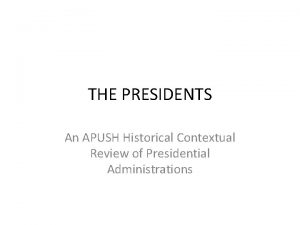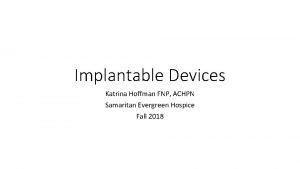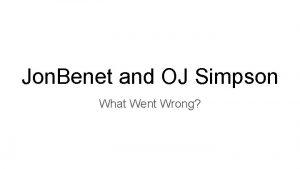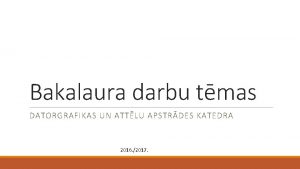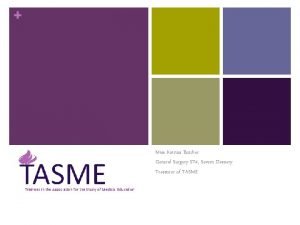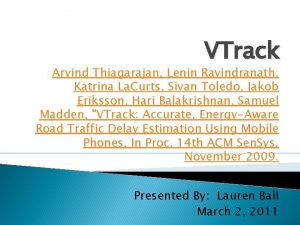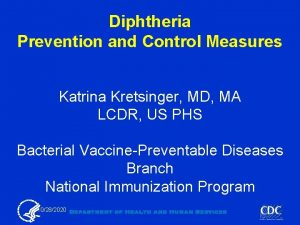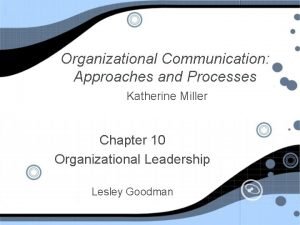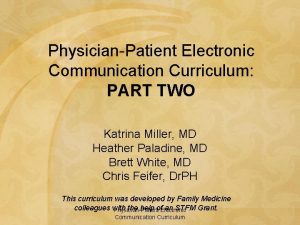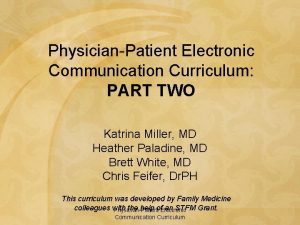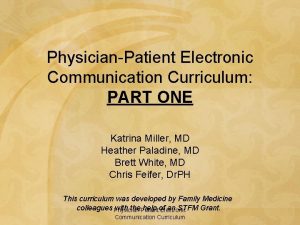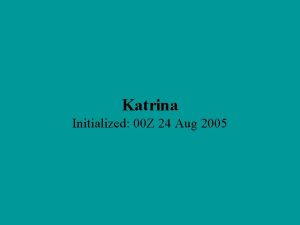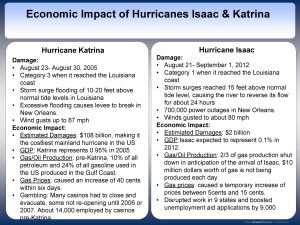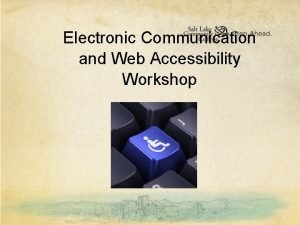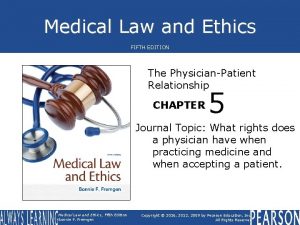PhysicianPatient Electronic Communication Curriculum PART TWO Katrina Miller






























- Slides: 30

Physician-Patient Electronic Communication Curriculum: PART TWO Katrina Miller, MD Heather Paladine, MD Brett White, MD Chris Feifer, Dr. PH This curriculum was developed by Family Medicine colleagues with the help of. Electronic an STFM Grant. Physician-Patient Communication Curriculum

Corresponding Author • Heather Paladine, MD Assistant Clinical Professor of Medicine New York Presbyterian/Columbia University Medical Center for Family and Community Medicine 610 West 158 th St New York, NY 10032 212 -544 -1864 hlp 11@columbia. edu 10/23/2021 Physician-Patient Electronic Communication Curriculum 2

Overview of Curriculum • Part 1: Background, Terminology, Security and Guidelines, Informed Consent and Documentation • Part 2: Appropriate Communications, Problem Situations and Sample Scenarios 10/23/2021 Physician-Patient Electronic Communication Curriculum 3

Part 1: Background, Terminology, Rules and Regulations, Documentation and Informed Consent Objectives: At the completion of this section, the learner will be able to: • Define specific terms and guidelines related to physician-patient email. • Discuss security issues with regard to email. • Identify guidelines for email communication. • Complete an informed consent with a patient. 10/23/2021 Physician-Patient Electronic Communication Curriculum 4

Part 2: Appropriate Communications, Problem Situations and Practice Scenarios Objectives: At the completion of this section, the learner will be able to: • Understand appropriate electronic communication. • Understand inappropriate patients with whom to communicate electronically. • Understand inappropriate topics for electronic communication. • Recognize how and when to end electronic communication and change to another form of communication. • Critique electronic communication with patients based on presented guidelines 10/23/2021 Physician-Patient Electronic Communication Curriculum 5

Conditions for the Use of Electronic Communication • Patients should be educated about the following: – Physicians cannot guarantee but will use reasonable means to maintain security and confidentiality of electronic information sent and received. – Physicians are not liable for improper disclosure of confidential information that is not caused by physician’s intentional misconduct. 10/23/2021 Physician-Patient Electronic Communication Curriculum 6

Conditions for the Use of Electronic Communication (cont) • Patients should be educated about the following: • Email is not appropriate for urgent or emergency situations. The physician should establish appropriate response times and adhere to these times. • Electronic communication must be concise. The patient should schedule an appointment if the issue is too complex or sensitive to discuss via email. 10/23/2021 Physician-Patient Electronic Communication Curriculum 7

Conditions for the Use of Electronic Communication (cont) • The patient should be aware that all electronic communication will be printed and/or filed in the medical record. • Office staff may receive and read patient messages. • It is the patient’s responsibility to follow up and/or schedule an appointment if warranted. 10/23/2021 Physician-Patient Electronic Communication Curriculum 8

Professionalism in Electronic Communication • Do not underestimate the effect of a well written email. • Older age groups expect an email to look like a written business letter, with a greeting, a body and a closing. • Proper grammar, capitalization and punctuation should be used • Use full sentences whenever possible • Keep medical jargon to a minimum 10/23/2021 Physician-Patient Electronic Communication Curriculum 9

Look at the difference “evehere’s the results of your test- hgb- 12 dr. j” • Discussion- How many ways could you improve this email? OR 10/23/2021 Physician-Patient Electronic Communication Curriculum 10

Look at the difference “Mrs. NHere are the results of your test from 8/1/09. Your hemoglobin was normal at 12 with a normal range 11 -13. Your anemia is improved. Please return to the clinic in 3 months for a follow-up visit. Best Regards, Dr. C” • Discussion: Should the email have a follow up plan, just like a chart note? 10/23/2021 Physician-Patient Electronic Communication Curriculum 11

Which Patients are Appropriate to Email? • Patients who understand information on an informed consent document and can sign for themselves • Patients who are 18 and over. • Patients who do not require an interpreter. • Established patients who have seen you previously in the office • Double-check all "To: " fields prior to sending messages- make sure it is the right person. 10/23/2021 Physician-Patient Electronic Communication Curriculum 12

Who Should Use Electronic Communication? • Medical advice that is provided by email should come directly from a licensed health care professional or their designee who is familiar with the patient. • If a clinician/staff designee is off for vacation or other extended leave, the clinician/staff designee should set up a vacation response on their email. 10/23/2021 Physician-Patient Electronic Communication Curriculum 13

Who Initiates Electronic Communication? • Generally the patient: – “Can you give me the results of my tests? ” – “I think I have an infection…” – “Doc- I have a question, actually a few…” – “I would like to make an appointment…” 10/23/2021 Physician-Patient Electronic Communication Curriculum 14

Answering Questions • If you have time and specific knowledge, you can answer questions via email. • Keep in mind this may start an email conversation, which may potentially take up more time than other communication methods. • Sometimes the most efficient way to address questions is in person or via telephone 10/23/2021 Physician-Patient Electronic Communication Curriculum 15

Sample Email “Doc- I have a question, actually a few…” “ Dear Ms. N, I have received your list of questions and regret to inform you that I cannot answer these questions via email. Please call our office and make an appointment with me at your earliest convenience Sincerely, Dr. M” 10/23/2021 Physician-Patient Electronic Communication Curriculum 16

Sample Email (cont) “Can you give me the results of my tests? ” “Dear Mr. J, Your blood tests all show normal results. Please call our office for further information. Sincerely, Dr. H” • Discuss: How does this sound? How would you change this? 10/23/2021 Physician-Patient Electronic Communication Curriculum 17

Sample Email (cont) “Can you give me the results of my tests? ” “Dear Mr. U, I am unable to give you the results of your tests via email. Please feel free to call the office or make an appointment to discuss the results. I will also send you a letter to this effect. Thank you, Dr. W” • Discuss: Would you send this email? Or would you call the patient directly? 10/23/2021 Physician-Patient Electronic Communication Curriculum 18

Sample Email (cont) “Doc- I have a question, actually a few…” “Dear Mr. NThat is a very good question and here is what I know…. for your other questions, please feel free to make an appointment and see me in the office. Best, Dr. G” 10/23/2021 Physician-Patient Electronic Communication Curriculum 19

Inappropriate Email Topics What type of information should the physician NOT email? • State laws may not allow certain information to be sent by email • In general, HIV test results and abnormal lab results should not be emailed • Complex info and new diagnoses are better communicated in person or by phone • General rule: don't send any info by email that will generate more questions than answers! 10/23/2021 Physician-Patient Electronic Communication Curriculum 20

Inappropriate Email Topics What type of information should your patient NOT email? • Any potentially serious problem - chest pain, difficulty breathing, etc. • Time sensitive info: "Please let me know today" • Complex info that would be better communicated during an appointment - multiple questions, etc. • Remember, you can always ask the patient to make an appointment! • It is the patient’s responsibility to follow up and/or schedule an appointment if warranted. 10/23/2021 Physician-Patient Electronic Communication Curriculum 21

Inappropriate Email Components • The subject line in emails should not contain personal information (e. g. name, ID number). • Social Security number should not be used in any part of an email • The subject should not be too revealing, ie: “My/Your positive herpes result”. 10/23/2021 Physician-Patient Electronic Communication Curriculum 22

Email Tone • Clinicians should maintain professional language and tone. • Irony, sarcasm, and harsh criticism should not be attempted in e-mail messages. – That which may be considered humor by one, may be taken offensively by another • Providers must realize that sick, anxious, or angry patients might indeed express stronger sentiments with e-mail than they would face-toface or over the phone. 10/23/2021 Physician-Patient Electronic Communication Curriculum 23

Which Patients Should NOT be Emailed? • Angry patients or patients in overly emotional situations or states. • Patients who repeatedly send emails that are too complex or have too many questions. • Any patient that you feel would be inappropriate in email communication – use your judgment, it is your decision to email or not to email! 10/23/2021 Physician-Patient Electronic Communication Curriculum 24

How to End an Email Conversation? Options: • Call the patient yourself. • Have an office staff member call the patient to make an appointment. • Email the patient a response that advises them to make an appointment 10/23/2021 Physician-Patient Electronic Communication Curriculum 25

Precepting Electronic Communication • Just as patients in the clinic are precepted, so should electronic communication. • If your residency does not have a competency requirement for electronic communication, consider setting one. • Emails can be precepted during a clinic session with a preceptor or via electronic means with a copy sent to the preceptor before sending to the patient • If you are ever unsure about how to react to an email from a patient, ASK FIRST – Remember that the electronic communication is legal documentation. 10/23/2021 Physician-Patient Electronic Communication Curriculum 26

Emails to Discuss • Following are sample emails for you to review and discuss. • The following 15 emails were created based on actual emails received by the authors. • You may choose to work individually or in small groups with one or more emails. Think about how you would respond and consider the thought questions. Then, discuss your thoughts in the full group. 10/23/2021 Physician-Patient Electronic Communication Curriculum 27

Sample Emails Group 1 • Pap Results • Problems! • I’m pissed! Group 2 • Glasses/apathetic staff • Orthotics • Heart problem Group 3 • A few issues • Does my hemorrhoid need surgery? • My baby is choking! 10/23/2021 Group 4 • Reflux, I think • Pain Medications • I ran out of birth control pills Group 5 • A few things. • Need my results today! • Your horrendous care Physician-Patient Electronic Communication Curriculum 28

Questions? Can you now: • Understand appropriate email communication? • Understand inappropriate patients with whom to email? • Understand inappropriate email subjects? • Recognize how and when to end email communication and change to another form of communication? • Critique email communications with patients based on presented guidelines? 10/23/2021 Physician-Patient Electronic Communication Curriculum 29

END Physician-Patient Email Communication Curriculum: PART TWO This curriculum was developed by Family Medicine colleagues with the help of. Electronic an STFM Grant. Physician-Patient Communication Curriculum
 110 family of directions
110 family of directions Daniel miller arthur miller
Daniel miller arthur miller Medical plaza miller 131 miller street
Medical plaza miller 131 miller street Scrip exchange
Scrip exchange Electronic news gathering and electronic field production
Electronic news gathering and electronic field production Katrina flood map by address
Katrina flood map by address Hurricane katrina apush
Hurricane katrina apush Katrina gardner
Katrina gardner Katrina connors
Katrina connors Katrina amateur
Katrina amateur Healthfitness law
Healthfitness law Katrina pollard
Katrina pollard Katrina robinson mbe
Katrina robinson mbe Katrina hoffman
Katrina hoffman Katrina tornade
Katrina tornade Katrina balovlenkov
Katrina balovlenkov Katrina benet
Katrina benet Katrina hickey
Katrina hickey Katrina cohen-palacios
Katrina cohen-palacios Katrina boločko
Katrina boločko Tasme conference
Tasme conference Hurricane katrina webquest
Hurricane katrina webquest Katrina
Katrina Katrina maxwell
Katrina maxwell Katrina ramonell
Katrina ramonell Arvind thiagarajan
Arvind thiagarajan Katrina kang
Katrina kang Preventive measures of diphtheria
Preventive measures of diphtheria Organizational communication approaches and processes
Organizational communication approaches and processes Principles of electronic communication systems 3rd edition
Principles of electronic communication systems 3rd edition The history of electronic communication
The history of electronic communication






